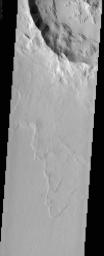Amazonis Planitia
Caption:

(Released 5 July 2002)
This is an image of a crater within part of Amazonis Planitia, located at 22.9N, 152.5W. This image features a number of common features exhibited by Martian craters. The crater is sufficiently large to exhibit a central peak that is seen in the upper right hand corner if the image. Also apparent is the slump blocks on the inside of the crater walls. When the crater was first formed, the crater walls were unstable and subsequently formed a series of landslides over time that formed the hummocky terrain just inside the present crater wall. While these cratering features are common to craters formed on other planetary bodies, such as the moon, the ejecta blanket surrounding the crater displays a morphology that is more unique to Mars. The lobate morphology implies that the ejecta blanket was emplaced in an almost fluid fashion rather than the traditional ballistic ejecta emplacement. This crater morphology occurs on Mars where water ice is suspected to be present just beneath the surface. The impact that created the crater would have enough energy to melt large amounts of water that could form the mud or debris flows that characterize the ejecta morphology that is seen in this image.
Cataloging Keywords:
| Name |
Value |
Additional Values |
| Target |
Mars |
|
| System |
|
|
| Target Type |
Planet |
|
| Mission |
2001 Mars Odyssey |
|
| Instrument Host |
Mars Odyssey |
|
| Host Type |
Orbiter |
|
| Instrument |
Thermal Emission Imaging System (THEMIS) |
|
| Detector |
|
|
| Extra Keywords |
Crater, Grayscale, Impact, Water |
| Acquisition Date |
|
| Release Date |
2002-07-08 |
| Date in Caption |
2002-07-05 |
|
| Image Credit |
NASA/JPL/Arizona State University |
| Source |
photojournal.jpl.nasa.gov/catalog/PIA03843 |
| Identifier |
PIA03843 |


